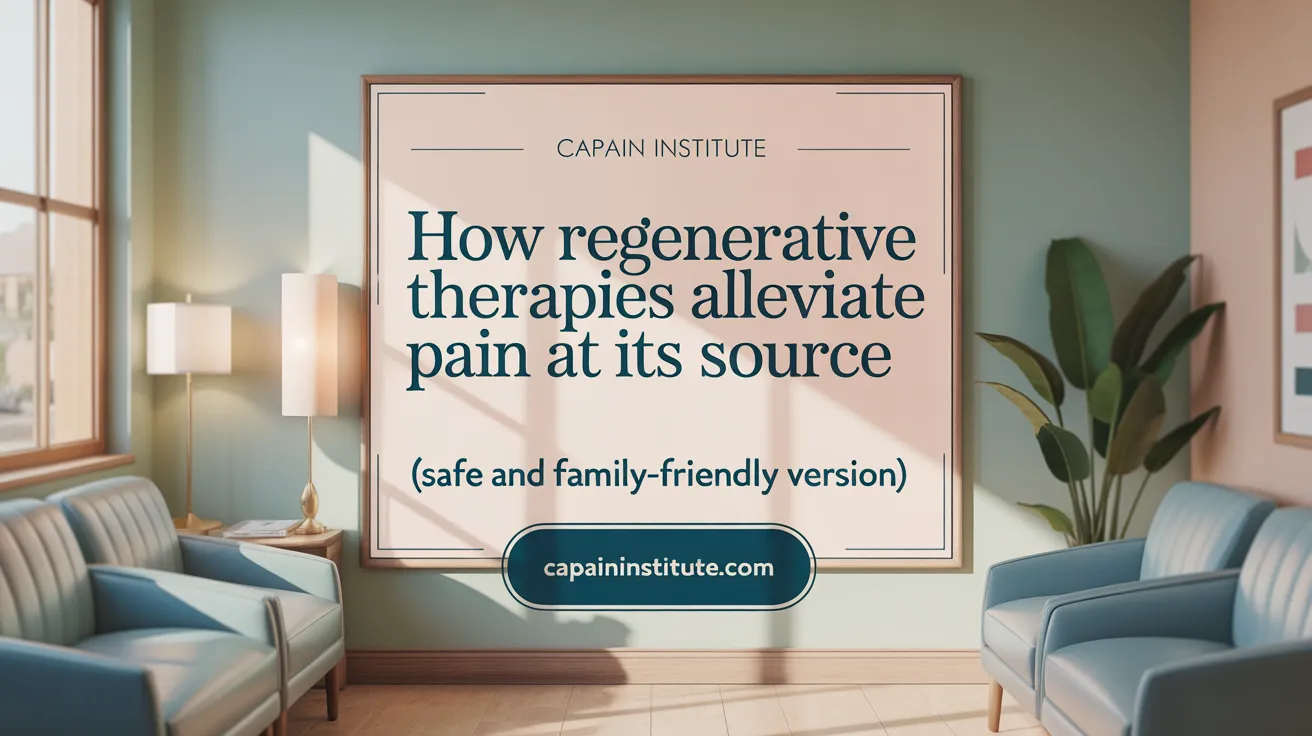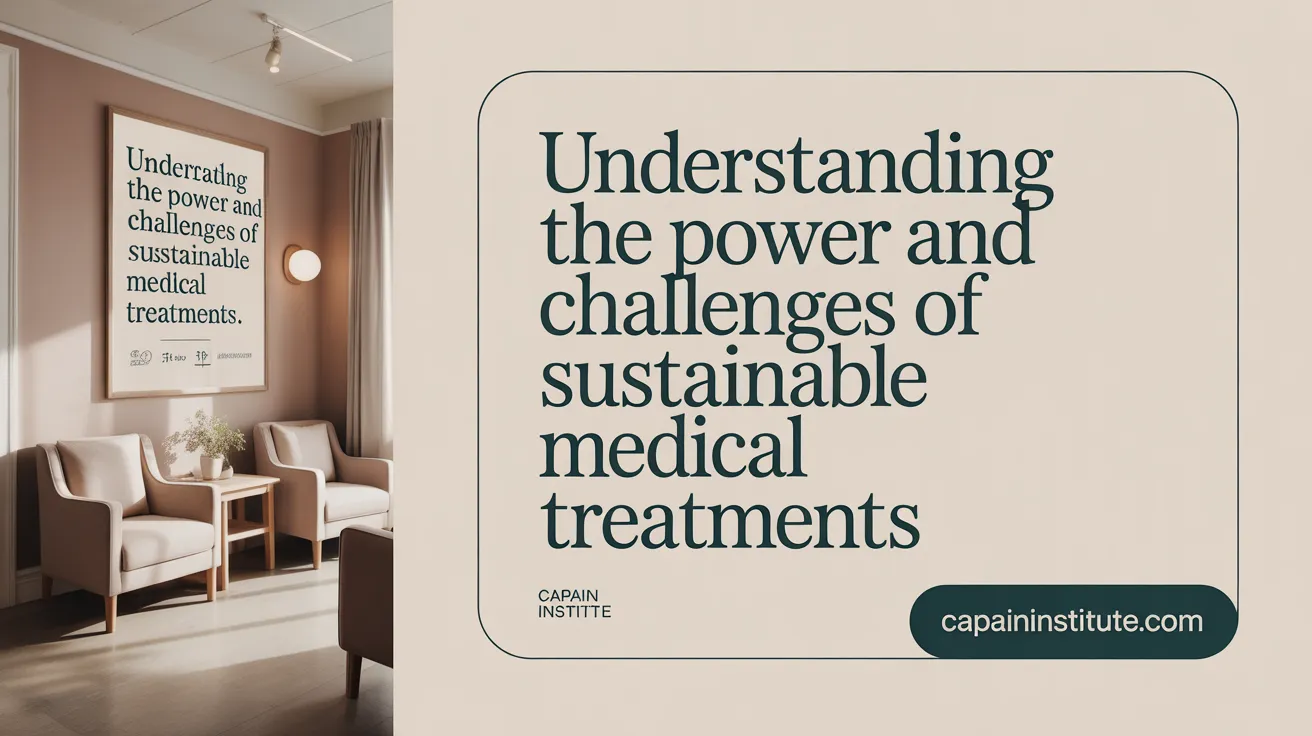Exploring New Frontiers in Pain Therapy
Advances in regenerative medicine are transforming how chronic and orthopedic pain is treated by shifting the focus from symptom management to repairing and rejuvenating damaged tissues. This article delves into the latest breakthroughs, clinical applications, and future directions of regenerative therapies such as stem cell treatments, platelet-rich plasma, tissue engineering, peptides, and biomimetic materials. By harnessing the body's natural healing abilities, these innovative methods offer promising avenues for effective and lasting pain relief, especially in conditions like osteoarthritis and arthritis-related joint pain.
<!-- VIDEO:eyJsaW5rIjoiaHR0cHM6Ly93d3cueW91dHViZS5jb20vd2F0Y2g/dj1xUkN4dk5YR3g5ZyIsImltYWdlVXJsIjoiZGF0YTppbWFnZS9qcGVnO2Jhc2U2NCwvOWovNEFBUVNrWkpSZ0FCQVFBQUFRQUJBQUQvMndDRUFBa0dCd2dIQmdrSUJ3Z0tDZ2tMRFJZUERRd01EUnNVRlJBV0lCMGlJaUFkSHg4a0tEUXNKQ1l4Sng4ZkxUMHRNVFUzT2pvNkl5cy9SRDg0UXpRNU9qY0JDZ29LRFF3TkdnOFBHamNsSHlVM056YzNOemMzTnpjM056YzNOemMzTnpjM056YzNOemMzTnpjM056YzNOemMzTnpjM056YzNOemMzTnpjM056YzNOLy9BQUJFSUFGTUFsQU1CSWdBQ0VRRURFUUgveEFBYkFBQUFCd0VBQUFBQUFBQUFBQUFBQUFBQUFRSURCQVVHQi8vRUFEZ1FBQUlCQXdNQkJnTUdCQWNCQUFBQUFBRUNBd0FFRVFVU0lURUdFeUpCVVdGeGdhRVVNcEd4d2RFSFFuTHdGU05TWTZMUzRXTC94QUFhQVFBQ0F3RUJBQUFBQUFBQUFBQUFBQUFCQWdBREJRUUcvOFFBSnhFQUFnSUJBd01DQndBQUFBQUFBQUFBQUFFQ0VRTVNJVEVFRkVGUllRVVRJaU15Y2FILzJnQU1Bd0VBQWhFREVRQS9BTFNHV0p1TWRGcVN2ZEVMakdDYXpkdmZvUnc0T1VKSE5USXJ3RkkrZmF1bHBqVVhlMWVUaWtOQ25oWGFPT2FyeGRjSEJxUGM2M0RCT0ltTEh5Wmw1Mi9HbWhDYzNVVVZaSnh4cTVPaE90ZDNDbUFnOGVjOGVoWDl6V1J2NVZONU5qanhmcFYvcmR5b1JRN2dFazQvNDFscjBoN3RpcERLVG5PSzZzRGFFemRMSE9xZXhJamx6d2VSNzFPampVaklGVVI4R1NXMm40MEYxRjBaVlJ5Um5CelhZc2htWnZoT1NyaEl1NWxWVnpVS09ReFhTU29BV1Jnd0I2WkJ6VGp0dTZWS3N0Slc0dzl4Y3h3b2VjS2R6SDlxZWRKYm1mZ3h5dWthYTM3V1c2eHhtNmlsaVoxeng0aFVvOXJ0UHdOalROa1pHRXgrZFpyVUhodEhVUnhyY3hxQmd5cit4cG04dklsaVFwWndwa1p5RlA4QTJyTCtSSDAvcHR2cVd2UEhzTDdWYXU5L2N4aFlnSTR3ZGpic2xzNHo4S290N0hxYWtzMGR6OTd2QTRHQWVveDg2amxkaDVJK0lQRmRtRnVNRkF6dW8rcWJuNmhkZk9wVnBBODhnamp4bnpKUFNwRm5wdVFKYnd0R25VSU9HYjloL3dDZXVhTFV0UmpoaVpMWTdFUlRreDhESHQ1L09wTEo0aUNHRzFjOWtPZHBabVhTNG9RK1FycXUxY0JSajh6V1pkUVdMUzhJRDBQblY1cVU5czJrVzh6U0JvK0dHT2R4ckwzZDVnbVI4YjIrNnZwV2JKbTFGRTB6eU5ncHNSY2NBOFVLejBranlOdVluUHhvVlZaWVgwVjNkUkFZZGhqMXFaRnJseWk0YkJVYzhjVXgzUks3Z3AyK3VLT08yYWQ5a1NGbVBrQldqcy9CMTNFdWJQWHpOTDNlQ0hjOGVncHk0ZGlyczNVOGsxQjArd052ZUs4bXdzcWs3Vk9jZVZPMzB1RVlEalBrSzdlbmdzYWJNRDRsa2psbkdNSGFEMUcvRXl4aVRLbFIwem5PZjdGVk10eVNjb01lOUhCYVRUdUVpUjVHL3dCS0tXUDRDci9UdXhXdTNwQmcweVlLZjVwQnRIMTVya2NveE4xVWtaa2lTUTVPZm5TaEI2OWE2YnAzOEpkVW13YjY1aHR4NWhmRWEwdGgvQ2ZTSXNHN25ubkk2ODRIMHhWVXVwZ3ZJc3BxdGpqMjVsakM3dWdwUkpXUjlwSTVOZDhIWVBzNHR1MFgrR3hNRC9OanhmalhLdTNYWlk5bnRWVVJFdGFYQUxSTWZJanFwL0VmMktLNm1NM1JpOXBPRnN6MGM4eWM3eTNzZWFjaVdlOFpJYmUzYVNZZ25BNTQrSFFENDBtTzBsbUJDZVhWcXZ1emxtMXROY05jSnVSNGdFLytpQ0QrblBwVWxsU1d3MGNFbnpzaGkxN015U0VIVUx0WXZNb2hETVAwRk4zbHRZNlRLenhNOHJJUVkrOE9Ob0h5NisvNGRPZEluZVhwSWdUYkYwTWlqS2orblAzajc5QjcxanUwVVN3NnZQREh1MkpnRGMyVDBHU1RWY01rcE9teTNMaWpqaGFReGRhaE5jWkRZVWVZSG44YVpTRVNuL1BZTEg1Ky90VVdXY1IvY0FZL1FWRW11SE9XTDgwWjV0SzB4S3NmVHVjdGN3dFl1Vk1valJRUW5FY1k2TDcxVWR6SkkyWDVKcDBUcUdabXdXSjZta1NYaFBDMXgyYUZBK3lqeklvNllNN2s5YUZDd25RTlJtVklBa1NCSTBYQVVkS2Iwa1BIWXZMQ0YzU05na25IRk5KRmY0MklrYVIvN2gzZlEwNDNmUUlGZS9SUi9wU05WQStsZWljVTJ2WXhJeWxHTWszK1FxT0ZrTWtyRVlLNHh1Qi9XcG5aV3lqMVR0YnBkamNSaDRwWnNzcDVES3FsaUQrRlZidW1Od2xFbWZQY0QrbFhuOE83eElPMitsTStjTkkwZkhrV1JsSDFJcGM3ckhKcm1oTVMrN0ZlRHVsbnBPbjJTQmJhMGlqQTlGNlZPR0FNQ2tuSjYrVlJiL1U3SFRZZSt2cm1LQlBWMkFyenU3UFFFbzVQU2pBNHJudXQvd0FVckMzM1I2WGJ0Y3Y1TTNoWDk2eUdzOXNOYjFHWm9aTG1TQkFSdVczNENuSElKODhIanI1VTZ4eUkrRHRGMWYyZG1NM1YzQkNQOXlRTCtkWXZ0ZnFXaTlwZE1sc3JHZExxN2hQZVFZVWdieDVaUFhPY2ZFaXVhUjIwMTNKek1DVHlUazQ5elU2R2FMUm1pZUhNa3NiRmk2ZmZmT0Fkb1BUZ2Rldkhsa2ltbkJRNFltR1d1OVNJMEttTkJKY3NxZ0RpRkRnRCtvajhnZkk1d1JnMldqempVTGllSnc1UlV6bGVOM1A1ZlNxZlc0SGJXbnViZTVqUzNtVVNEREh3NTZnRDRnNDlzVlY2cDJrK3hSTmEyY2hsbE9ON25nTFNLM3dYVHJsczNHcDZ4WWFQRXZmT0ZsUFNORHVZL1RpdWRhNXJpMzk1UE9VV0l5Tm5HYytWWis2MUNXWjJkbkx5TjFjbW9aY3QxTk5kRkwzTE9XNkczd3VEN0NvTWt4WWtrazB3VFJaelFzbEJzeE5BREF6U2FQUEZLTUVTYzBLVFFwU1ViYU83dWJrWVdNUnFmNW1PVCtBbzJpZ1Z2RktTL25nL3RUMXRjanZraWdVQlJ5ek1Na2o5S24vYWxFUVlCU3paT1NLMmU3U2ZCbWR0SnJtaXFmYUZ4bGlQZlA2MDdvRno5aDdSYVpkS3U0UjNjVGJRUU0rSWNjMFZ6UEsyY1F4dG4rWmVUVUVNMjRQc1pkcHpqSFNqM0VjaTBpTEJMRzd1enJlcTl2Tlh1VWY3S0xlMUJCVVJvUTdBK1JMZFBVNEhwNlZqTHR0UnZKejlxbWVjdWNzWnprRDVIcCtOUzdlU1NlQkpZQVdXVmM0UlJpbEFzckQvQUNXQUJiZ25KWFBTc3h5VWRrYks5U3VFZmR0dFIwakFPZHlSYm1IeFBsOHFkK3hBb29HVjNMa050NElQei9LcFRSMm5kTTF6SStPU0ZURlkrNjErZEMwVUFFVVlQRzNxZmpRakt3VGRHb3ZybGJJdVZraldNY0JtNjRIQTQrSDYxbUx2dEZ1a2J1a0JPZUpHNU5VbDVlU3pzUzdrL0UxQWtsOUtMcnlWZm9zN3ZWcFhEWWM3bTZ0VlN6czU2bkZFTXNlYVdCUzNZYW9UakZIU3FHM05EZ2czak5IaWw3YUJBcFFpTnRFM0FwWjRGTk1jbWdFVGloUzl3RkNnRTJkc3Bpc3A3ZzlXOEM1K3RGZjNDVzBjU3lUWThIUURuOEtlMWVhTzF0WTdXTEIyQVZRM01UWGM1bWtrenh6WFJaejBGUHFvQnhBaC9xYnJTYlQvQUJEVUpjd3ZKSVU1UGk0RlBXT25SM2x4M01LWjI4dXhQQ2l0UFlXWmhpRVZwRUk0RjVMTWNaUHFhT3FnMEwwUzgxTzBpN21WQ2krdkIvS3IyeUFhV0tkbklPN2M0enhnVlZTQllrM3pUS285alZlK3IyMGNxckcyODV4Z2M1K2RWU2pxZGxzY21sVVROZG4rejJycWNiMjZFWkhGWW1YbkxNYXUrMFY1dWtDaytMSDNCNWZHczVLNVBubW5qc2hadHlkamN6QS9kTk1xbVR6VGhUem9BK1ZDdDl5QTJqeW9BVXNMbm1pSW9Oa0NDMG9ERkFVWmFsQ0lZMGdtalpxYVpxQVVnbmFrODBLMC9aMkRUNTlQM1hJdGc2T1Zmdk51NGpCYklPT09GUFgwUHdwUmpNVUtPVmcwanNBQUNTUUFNQVVkUWhvTlFkbWxjc1NlYXI1WFlMMU5DaFhRVW8xdlpWRlhTd3lqRFB1TEgxd2F0TW51dCtmRlFvVlhMa2hUNmpDbHd4ZVlGbS9xTlVvaldLK1R1eGpCeU9mWTBLRlBFaEZ1eVRsaWNrOGsxREhXaW9WUEpCZEJBTS9PaW9VWkVROWdZcHR1dENoVlRHUVJwRDBLRkFJMGV0SU5DaFFHQXRIa2hHQUpBUEJBUFdoUXFFR3FGQ2hTaFAvWiIsInRpdGxlIjoiUmVnZW5lcmF0aXZlIE1lZGljaW5lOiBNYWtpbmcgdGhlIEltcG9zc2libGUgUG9zc2libGUiLCJzbmlwcGV0IjoiMjAyMSdzIEJyZWFrdGhyb3VnaHMgaW4gTmV1cm9zY2llbmNlIGFuZCBPdGhlciBCaW9sb2d5IC4uLiBDYXRoeTogUGFpbiBGcmVlIFJlbGllZiBvZiBTZXZlcmUgSGlwIEFydGhyaXRpcyBhZnRlciBSZWdlbmVyYXRpdmUgU3RlbSBDZWxsIGFuZCBQUlAgLi4uIn0= -->Recent Advancements in Regenerative Medicine for Pain Relief

What recent advancements have been made in regenerative medicine for pain relief?
Recent progress in regenerative medicine has significantly enhanced treatment options for managing chronic pain, especially in joints and tissues affected by degenerative diseases like osteoarthritis. One notable development is in stem cell therapies, particularly focusing on mesenchymal stem cells (MSCs). These cells, sourced from bone marrow or adipose tissue, have shown promising results in cartilage repair and improving joint function, surpassing some traditional techniques like microfracture surgery.
Alongside stem cell advances, platelet-rich plasma (PRP) treatments continue to evolve. PRP involves concentrating platelets from a patient’s own blood, rich in growth factors, which are then injected into damaged tissues. While PRP provides effective short-term relief for acute injuries and tendinopathies, ongoing research aims to optimize preparation methods for more consistent long-term outcomes.
Tissue engineering is also advancing rapidly. Researchers are utilizing 3D bioprinting and developing biomimetic scaffolds such as hydrogels and nanofibers. These materials support cell growth and tissue regeneration, providing structural support that encourages the body’s healing processes and aids in restoring joint stability.
Emerging therapies like gene editing and exosome-based treatments are opening new horizons. Gene therapies aim to modulate molecular pathways involved in inflammation and cartilage degradation, using vectors like viral delivery systems. Meanwhile, exosomes—cell-derived vesicles—carry proteins and genetic material to promote tissue repair and reduce inflammation, showing promise in treating musculoskeletal conditions.
These scientific and technological strides are collectively aimed at addressing the underlying causes of pain, reducing reliance on invasive procedures, and achieving sustainable, long-lasting relief for patients with degenerative and traumatic tissue damage.
| Treatment Type | Main Focus | Recent Innovation | Potential Benefits |
|---|---|---|---|
| MSC Therapy | Cartilage Regeneration | Bone marrow and adipose sources, enhanced differentiation | Long-term tissue repair, improved joint function |
| PRP | Inflammation & Healing | Improved preparation methods for consistency | Short-term pain relief, tissue healing |
| Tissue Engineering | Structural Support | 3D bioprinting, hydrogels, nanofibers | Restores tissue integrity, accelerates healing |
| Gene & Exosome Therapies | Molecular Signaling | Targeted gene editing, vesicle-based treatments | Reduces inflammation, promotes regeneration |
As regenerative medicine continues to evolve, further research and large-scale clinical trials are essential to fully establish the safety and long-term effectiveness of these innovative therapies.
Mechanisms and Contributions of Regenerative Therapies in Pain Management

How do regenerative therapies like stem cell therapy, PRP, tissue engineering, peptides, and biomimetics contribute to pain management?
Regenerative therapies play a pivotal role in managing pain by addressing its root causes—damaged tissues and inflammation—rather than merely relieving symptoms. Stem cell therapy, especially using mesenchymal stem cells (MSCs), helps repair cartilage, tendons, and ligaments, often resulting in reduced joint pain and improved mobility. These stem cells can differentiate into chondrocytes, the cells responsible for healthy cartilage, facilitating tissue regeneration.
Platelet-rich plasma (PRP) therapy delivers a concentration of growth factors directly into injured tissues like tendons or joints. This accelerates natural healing processes, leading to decreased inflammation and pain, particularly in acute injuries. Though its effectiveness varies in chronic conditions, PRP remains a popular minimally invasive option.
Tissue engineering, including the use of scaffolds and bioactive materials, supports tissue regeneration by creating a conducive environment for cell growth. Biomimetic scaffolds mimic natural tissue architecture, enhancing cellular migration and tissue integration. These approaches improve joint stability and function, helping to reduce chronic pain.
Peptides, especially growth factor peptides and antimicrobial peptides, support tissue repair and combat infections that can cause persistent pain. Bioengineered peptides stimulate cell proliferation and healing, while antimicrobial peptides help prevent infections that might complicate tissue regeneration.
Advanced drug delivery systems like nanoparticles are designed to release pain-relief agents directly at the pain site. By targeting nociceptors—nerve cells responsible for pain transmission—these systems provide effective pain control with fewer systemic side effects.
Reactive oxygen species (ROS) scavengers represent another innovative approach. They neutralize oxidative stress and inflammation within tissues, which are heavily implicated in chronic pain conditions such as osteoarthritis. These scavengers can reduce nociceptor activation and tissue damage, further alleviating pain.
In summary, regenerative therapies contribute to pain management by promoting tissue repair, modulating immune responses, and interfering with pain signaling pathways. These minimally invasive techniques aim to restore tissue health, reduce inflammation, and provide lasting pain relief, offering hope for individuals with chronic or degenerative conditions.
Clinical Applications and Research Insights on Regenerative Pain Treatments
 Regenerative medicine offers promising options for managing pain related to musculoskeletal and joint conditions. These therapies are increasingly being incorporated into clinical practice based on substantial research evidence. Treatments such as platelet-rich plasma (PRP), mesenchymal stem cells (MSCs), prolotherapy, and other tissue engineering approaches are used to promote tissue repair and modulate inflammation.
Regenerative medicine offers promising options for managing pain related to musculoskeletal and joint conditions. These therapies are increasingly being incorporated into clinical practice based on substantial research evidence. Treatments such as platelet-rich plasma (PRP), mesenchymal stem cells (MSCs), prolotherapy, and other tissue engineering approaches are used to promote tissue repair and modulate inflammation.
Clinical trials have demonstrated that PRP can provide short-term relief, especially in acute injuries and tendon issues. Its efficacy in chronic conditions, however, varies widely, largely due to differences in preparation techniques. MSC therapy has shown notable success in cartilage repair and early osteoarthritis, often exceeding the results of traditional microfracture procedures. In fact, meta-regression analyses indicate that stem cell treatments are particularly effective for pain reduction, with an impact coefficient showing statistical significance.
Prolotherapy involves injecting solutions like dextrose to stimulate healing of ligaments and tendons, which can alleviate joint instability and chronic pain. These interventions aim not just to relieve symptoms but to address underlying tissue damage, emphasizing tissue regeneration.
Research findings support the safety and potential of these regenerative approaches, although results depend on factors such as the patient’s condition, treatment timing, and method standardization. The ongoing development of personalized treatment plans, supported by advances in imaging, molecular profiling, and biomaterials, further enhances outcomes.
The applications extend to a variety of orthopedic issues, including osteoarthritis, tendinopathies, ligament injuries, and back pain. As research continues to progress, new combinations of therapies—like gene editing, growth factor delivery, and biomaterial scaffolds—are being evaluated to optimize pain relief and tissue regeneration.
In summary, current evidence underlines the importance of multidisciplinary, personalized approaches to regenerative medicine. These therapies hold the potential to reduce reliance on pain medications and surgical interventions, delivering longer-lasting and more natural healing effects.
For those interested in further details, searches with terms like 'clinical research regenerative medicine pain reduction' yield a wealth of ongoing studies and evolving treatment strategies.
Mechanisms, Benefits, and Limitations in Managing Chronic Pain and Orthopedic Conditions

What are the mechanisms, benefits, and limitations of regenerative medicine techniques in managing chronic pain and orthopedic conditions?
Regenerative medicine therapies work primarily by stimulating the body’s natural healing capacities. They involve mechanisms such as cellular regeneration, where stem cells are introduced to differentiate into tissue-specific cell types like chondrocytes for cartilage repair. These therapies also secrete growth factors that promote tissue repair, reduce inflammation, and support extracellular matrix remodeling.
For example, platelet-rich plasma (PRP) delivers concentrated growth factors directly to damaged tissues, speeding up healing processes. Similarly, stem cell treatments aim to replace or repair damaged tissues by fostering new cell growth, thereby alleviating pain and restoring function.
The benefits of these approaches are substantial. They can lead to significant improvements in tissue healing, pain reduction, and enhanced joint movement. Many patients experience longer-lasting relief compared to traditional symptom management. Therapies like stem cell and PRP treatments can stimulate cartilage regeneration, decrease inflammation, and even promote neuroplasticity, especially when combined with rehabilitation exercises.
Despite these advantages, there are notable limitations. Variability in how biologic products like PRP are prepared often results in inconsistent outcomes. The lack of standardized protocols means that efficacy can differ between clinics or studies. Moreover, while some techniques show promise in early trials, high-quality evidence supporting their widespread use remains limited.
Safety concerns also arise due to the biological nature of these therapies. Potential risks include infection, immune reactions, or undesirable tissue growth, although these are generally low when procedures are properly conducted.
Another challenge is the high cost associated with advanced regenerative treatments, which may not be covered by insurance and can restrict patient access. Additionally, ongoing research is necessary to refine these therapies, with innovations such as bioengineered scaffolds, gene editing, and combined regenerative-rehabilitation protocols aiming to address current limitations.
In conclusion, regenerative medicine holds great potential to transform the management of chronic pain and orthopedic conditions. Continued efforts toward standardization, robust clinical trials, and cost reduction are essential to maximize benefits and make these therapies accessible to a broader patient population.
Regenerative Medicine’s Role in Addressing Osteoarthritis and Arthritis-Related Pain
How does regenerative medicine address joint health issues such as osteoarthritis and arthritis-related pain?
Regenerative medicine focuses on repairing and restoring damaged joint tissues, especially cartilage, to alleviate osteoarthritis and arthritis-related pain. It employs techniques like platelet-rich plasma (PRP), stem cell therapy, and tissue engineering to stimulate the body’s natural healing processes. PRP uses a patient’s own blood to concentrate growth factors that promote tissue repair and reduce inflammation.
Stem cell treatments, especially involving mesenchymal stem cells derived from bone marrow or fat tissue, can differentiate into cartilage-producing cells called chondrocytes. These cells help regenerate damaged cartilage, reducing joint pain and improving function. Bioactive molecules such as growth factor peptides further support tissue regeneration.
Surgical approaches incorporate regenerative concepts with procedures like cartilage transplantation and bioengineered scaffolds to restore joint structure. This approach aims to delay disease progression by repairing the degenerative tissues before severe joint damage occurs.
Although results are promising, the effectiveness varies depending on factors like the extent of cartilage damage, treatment protocols, and individual patient responses. Ongoing research seeks to enhance cell survival and integration, aiming for more durable and structural tissue repair that can prolong joint health and decrease dependency on pain medications.
Emerging Technologies and Ongoing Research in Regenerative Pain Therapies
Future prospects in regenerative medicine for pain relief look highly encouraging, driven by rapid technological advancements and ongoing research efforts. Key innovations such as gene editing techniques like CRISPR enable precise modification of genetic pathways involved in tissue repair and inflammation control. This enables the development of targeted therapies to address chronic pain conditions more effectively.
3D bioprinting represents a groundbreaking approach to fabricating functional tissues and organs, which could be used to replace damaged joint cartilage or ligaments. Researchers are also exploring nanorobotics, tiny devices capable of delivering drugs directly to affected tissues at a cellular level, thereby enhancing treatment precision and reducing side effects.
Personalized medicine is becoming more prevalent, utilizing a patient’s own genetic and molecular profile to tailor regenerative treatments. AI-driven algorithms assist in diagnosing, planning, and optimizing therapies, making processes more efficient and outcomes more predictable.
Ongoing research is also delving into organoids—miniature, simplified versions of organs grown in labs that mimic real tissue behavior—providing valuable platforms for testing regenerative strategies.
Some promising future trends include the use of microRNA (miRNA) treatments to regulate gene expression involved in tissue regeneration and inflammation. These techniques could significantly improve healing outcomes.
Overall, the integration of these cutting-edge technologies aims to develop minimally invasive, highly targeted therapies that leverage the body's natural healing abilities. Challenges such as high costs and accessibility remain, but continuous innovations are paving the way toward more effective and long-lasting solutions for pain relief.
The trajectory of regenerative medicine is moving toward creating sophisticated, personalized, and efficient treatment options that could revolutionize how chronic and acute pain are managed in the near future.
Innovations in Biomaterials and Drug Delivery Systems for Pain Management
How are biomimetic scaffolds used in regenerative medicine?
Biomimetic scaffolds are engineered structures designed to imitate natural tissue environments, promoting cell growth and tissue repair. These scaffolds can be made from natural polymers like collagen and hyaluronic acid or synthetic materials such as PCL and PLGA. When implanted, they provide a supportive matrix that facilitates cartilage and bone regeneration, crucial for osteoarthritis and injury treatment.
What role do hydrogels play in tissue regeneration?
Hydrogels are injectable, water-rich networks that can conform to irregular tissue shapes. They serve as carriers for growth factors, stem cells, and drugs, enhancing targeted delivery and sustained release within damaged tissues. Hydrogels are especially useful in intervertebral disc regeneration and osteochondral repair, reducing invasive procedures and improving healing outcomes.
How do nanoparticles contribute to pain and tissue management?
Nanoparticles, such as ceria-zirconia, are designed to deliver drugs or act as scavengers of reactive oxygen species (ROS). They can target specific receptors or cells involved in pain pathways, offering non-opioid pain relief and reducing oxidative stress that exacerbates tissue damage. Examples include liposomes with targeting peptides and nanoparticles that cross the blood-brain barrier for nerve pain treatment.
What is controlled drug delivery and why is it important?
Controlled drug delivery systems allow medications to be released gradually over time at specific sites, improving efficacy and reducing side effects. Biomaterial carriers like hydrogels and scaffolds enable sustained release of analgesics and regenerative agents directly where needed, enhancing tissue repair and pain relief, while minimizing systemic exposure.
How do ROS scavengers aid in pain management?
Reactive oxygen species (ROS) are linked to inflammation and tissue degradation in chronic pain conditions. ROS scavengers, such as ceria-based nanoparticles, neutralize these damaging molecules. By reducing oxidative stress, these biomaterials can proactively decrease pain and promote healthy tissue environments.
What are injectable scaffolds and their benefits?
Injectable scaffolds are minimally invasive biomaterial constructs that solidify or gel inside the body, providing support for tissue regeneration. They are used in disc and joint repair, allowing precise placement, reducing surgical risks, and supporting cell and drug delivery directly within damaged sites.
Are non-opioid analgesics being incorporated into biomaterial systems?
Yes, advancements include developing targeted delivery systems for non-opioid analgesics such as NSAIDs and plant-derived compounds. These systems improve pain relief by localized, sustained release, reducing systemic side effects and dependence associated with opioid therapies.
| Biomaterials & Delivery Systems | Applications | Benefits | Additional Details |
|---|---|---|---|
| Biomimetic scaffolds | Cartilage & bone regeneration | Mimic natural tissue, support cell growth | Improve integration and repair |
| Hydrogels | Soft tissue, disc repair | Targeted, sustained delivery | Injectable, minimally invasive |
| Nanoparticles | Drug delivery, ROS scavenging | Precise targeting, reduce oxidative stress | Cross blood-brain barrier |
| Controlled release systems | Local analgesics & growth factors | Longer-lasting effects, fewer doses | Reduce systemic side effects |
Advances in these biomaterial technologies are creating more effective, personalized options for managing chronic pain and promoting tissue regeneration, aligning with ongoing research efforts in regenerative medicine.
Personalized Approaches and Clinical Integration of Regenerative Treatments
How are treatment plans tailored to individual patients?
Personalized regenerative medicine aims to customize therapies based on each patient's unique condition, such as their age, severity of tissue damage, and overall health. This approach involves detailed assessment and diagnostic testing to identify the most suitable treatment, whether PRP, stem cell therapy, or tissue engineering.
Do combination therapies improve outcomes?
Combining different regenerative techniques can enhance healing. For example, using stem cells along with biomaterials like hydrogels can promote better tissue integration and faster recovery. Multimodal strategies are increasingly common to address complex cases and improve long-term results.
Where are these treatments applied clinically?
Regenerative therapies are widely used in clinics specializing in orthopedics, sports medicine, and pain relief. They are effective for conditions such as osteoarthritis, tendon injuries, and spinal disc degeneration, often avoiding invasive surgeries and reducing recovery times.
How do clinics select suitable candidates?
Patient selection involves evaluating the extent of tissue damage, age, activity level, and previous treatments. Those with early-stage or moderate injuries tend to benefit most. A comprehensive consultation is essential to determine if regenerative options are appropriate.
Is multidisciplinary care involved?
Optimal results often come from a team approach involving orthopedic specialists, physical therapists, radiologists, and regenerative medicine experts. Collaboration ensures precise treatment delivery, monitoring, and integration with physical rehabilitation programs.
What about treatment safety?
Regenerative treatments typically use autologous cells and biocompatible materials, making them safe with a low risk of adverse effects. However, the lack of long-term data emphasizes the need for clinics to follow standardized protocols and conduct ongoing research to ensure patient safety and treatment efficacy.
A Transformative Era for Pain Relief Through Regenerative Medicine
Regenerative medicine is reshaping the landscape of pain management by offering innovative, biologically driven therapies that promote healing and tissue regeneration rather than merely masking symptoms. With promising clinical results in osteoarthritis, chronic orthopedic conditions, and acute injuries, these treatments provide minimally invasive options geared toward long-term pain relief and functional restoration. Ongoing advancements in biomaterials, gene therapy, and personalized medicine hold the promise of overcoming current limitations related to efficacy, safety, and cost. As research continues to unfold and clinical protocols are refined, regenerative medicine stands poised to become a cornerstone in the fight against chronic pain, improving the quality of life for millions worldwide.
References
- Advancements in Regenerative Therapies for Orthopedics
- The Future of Regenerative Medicine in Pain Relief
- integrating regenerative medicine, gene therapy and ...
- Regenerative Medicine: Helping the Body Heal Itself
- Biomaterials and Regenerative Medicine in Pain ...
- The Latest Advancements in Regenerative Medicine
- How Regenerative Medicine Is Revolutionizing Pain ...
- Regenerative Medicine for Chronic Pain Relief
